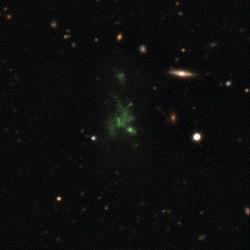Lyman-alpha blob 1
| Interstellar cloud | |
|---|---|
| Intergalactic cloud | |
 Polarized image of LAB-1, shown as the faint, green gas cloud. | |
| Observation data:J2000epoch | |
| Subtype | Lyman-alpha blob |
| Right ascension | 22h17m25.97s[1] |
| Declination | +00° 12′ 38.9″[1] |
| Distance | 1.15 × 1010ly |
| Constellation | Aquarius |
| Physical characteristics | |
| Radius | 150,000 ly |
| Designations | SMM J221726+0013,[1]WBG2010 C11 |
Lyman-alpha blob 1(LAB-1) is a giant cosmic cloud of gas located in theconstellationofAquarius,approximately 11.5 billion light-years from Earth with aredshift(z) of 3.09. It was discovered unexpectedly in 2000 by Charles Steidel and colleagues,[2]who were surveying for high-redshiftgalaxies using the 200 inch (5.08 m)Hale Telescopeat thePalomar Observatory.[3]The researchers had been investigating the abundance of galaxies in the young Universe when they came across two objects which would become known asLyman-alpha blobs[2]—huge concentrations of gases emitting theLyman-alphaemission line of hydrogen.[4]
LAB-1 is the first discovered Lyman-alpha blob; hence, it has the number 1. It is the prototype of objects of this kind.[3]It is also one of the largest of its kind, measuring 300,000 light years across, three times larger than theMilky Way.[4]The blob appears green on the image because of the combination of the high redshift (z= 3) and the ultraviolet nature of the blob.[4]Imaging with theEuropean Southern Observatory'sVery Large Telescopeshowed that much of the light from the blob is polarized, the proportion increasing and peaking at around 20% at a radius of 45kiloparsecs(145,000 light-years), forming a huge ring around the blob.[5]
It is still unclear as to why this object is emitting the Lyman-alpha emission radiation. It is thought that the light is coming from galaxies within the central region of the blob. Light of such intensities could be fromactive galaxiesorsupermassive black holesactively absorbing matter.[4]An alternate theory is that the light is from cooling gas falling into early galaxies, which has possibly come from cosmicfilaments(as galaxies are thought to form at the intersections of these filaments); however, the pattern ofpolarizationfound argues against this.[2]
Gallery[edit]
-
Computer simulation of a Lyman-alpha Blob.[6]
-
Left:Lyman alpha blob-1 as seen in Lyman-alpha (yellow), infrared (red) and ultraviolet (blue). The round blue object at the upper left of the blob is a giant galaxy.Right:Artist's impression of how the blob may look like if viewed from relatively close.
-
Lyman-alpha blob 1 seen by ESO's VLTMUSE
See also[edit]
References[edit]
- ^abc"SMM J221726+0013".SIMBAD.Centre de données astronomiques de Strasbourg.
- ^abcBower, Richard (2011)."Unlocking the Secrets of the Giant Blobs".Nature.476(3760): 288–89.Bibcode:2011Natur.476..288B.doi:10.1038/476288a.ISSN0028-0836.PMID21850099.
- ^abSteidel, Charles C.; Adelberger, Kurt L.; Shapley, Alice E. (2000). "Lyα Imaging of a Proto–Cluster Region at z = 3.09".Astrophysical Journal.532(1): 170–82.arXiv:astro-ph/9910144.Bibcode:2000ApJ...532..170S.doi:10.1086/308568.
- ^abcd"Giant Space Blob Glows from Within".ESO Press Release.17 August 2011.Retrieved18 August2011.
- ^Hayes, Matthew; Scarlata, Claudia; Siana, Brian (2011). "Central powering of the largest Lyman-[alpha] nebula is revealed by polarized radiation".Nature.476(3760): 304–07.arXiv:1108.3332.Bibcode:2011Natur.476..304H.doi:10.1038/nature10320.ISSN0028-0836.PMID21850104.S2CID4310494.
- ^"ALMA Uncovers Secrets of Giant Space Blob".www.eso.org.Retrieved23 September2016.

![Computer simulation of a Lyman-alpha Blob.[6]](https://upload.wikimedia.org/wikipedia/commons/thumb/3/30/Computer_simulation_of_a_Lyman-alpha_Blob.jpg/120px-Computer_simulation_of_a_Lyman-alpha_Blob.jpg)

